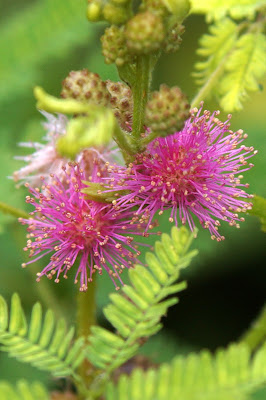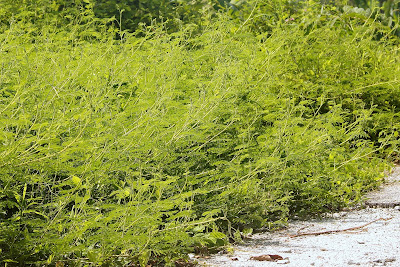Invasive Giant False Sensitive Mimosa
Giant False Sensitive Mimosa (Mimosa diplotricha) shares many features of its close relatives M. pudica. These legume has bipinnate leaves, composing of many leaflet which are sensitive to touch. What seems to be a single flower is actually numerous flowers held on a single head. Each of those tiny flower has long stamens forming a fluffy structure. A native plant of South America, Giant False Sensitive Mimosa has dispersed far and wide not only in Southeast Asia, but also in Polynesia and Taiwan.
 |
| Flowers of Giant False Sensitive Mimosa. |
Their successful colonisation in the tropics is partly due to its fruit which readily float on water, along with the fruit's spiky outer skin which easily attaches to animals and human as well. The seeds also germinate fast in the right habitat where there is a lot of sunlight, and if condition is unsuitable, they can also lay dormant for years before germinating.
 |
| Sprawling growth of Giant False Sensitive Mimosa. |
They are considered invasive species in many countries because their growth can potentially be a hazard to local plants and negatively affect crop yield. Removing sprawling growth of M. diplotricha (also known formerly as M. invisa) is a tough job because of its prickly nature and fast growth. For these reasons, some scientist has utilized biological control by introducing insects such as psyillid and moth larvae that feed on the flowers, leaves and shoots which could significantly reduce their viability.
Related Post
Mimosa pigra: A Notorious Invasive Tree
Related Post
Mimosa pigra: A Notorious Invasive Tree